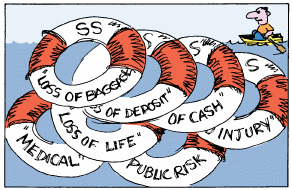
|

Many credit card issuers provide travel insurance cover free of charge if the cardholder pays for overseas travel using their credit card. What is credit card travel insurance? Credit card travel insurance covers cancellations, lost luggage and personal effects and medical, hospital and dental expenses. The extent of the coverage varies depending on the credit card used. As with all travel insurance, pre-existing medical conditions are excluded and upper age limits apply. The travel insurance covers the whole holiday if the credit card is used to pre-pay airfares, accommodation or a tour before leaving Australia. The coverage is comparable with stand-alone travel insurance cover because it is provided by the same Master Policy issuers, notably Allianz, Zurich and QBE. It is generally the ‘premium’ credit cards (Gold and Platinum), where a sizable annual fee is payable, that provide travel insurance cover. Some ‘premium’ debit cards also provide cover. ASIC says that cardholders find it hard to tell what cover they are getting ASIC sees cardholders as suffering from poor disclosure of the travel insurance policy terms. ASIC’s Deputy Chairman Peter Kell has identified this shortcoming in the ASIC (Australian Securities & Investments Commission) media release of 2 June 2015: Having travel insurance is essential ... on an overseas trip ... for when things go wrong. Credit card issuers and insurers must clearly set out what is and what is not covered by a policy, so that consumers can work out if they are adequately covered. Based on consumer complaints received by ASIC and the Financial Ombudsman Service about credit card travel insurance, ASIC is working with 17 credit card brands to improve disclosure, particularly to make it easier for cardholders to locate insurance policy terms and conditions on credit card issuer websites. The key terms in a credit card travel insurance policy Credit card travel insurance has key terms which are not found in stand-alone travel insurance policies. ASIC has identified these key terms as its focus for improved disclosure:
Extra benefits with credit card travel insurance Credit card travel insurance has extra benefits which are not found in stand-alone travel insurance. These are: credit card travel insurance applies to travel worldwide outside Australia; it can provide substantial accidental death benefits, and good rental car excess cover. And if a travel supplier cannot provide the travel (because of insolvency), a credit card chargeback is available. If a cardholder has stand-alone as well as credit card travel insurance, they cannot ‘double dip’. The rule is that the claim is made against the stand-alone insurance first, and if that does not satisfy the claim, against the credit card insurance for the remainder. Conclusion Paying by credit card to obtain ‘free’ travel insurance is smart because it does provide all the cover needed for a normal holiday for an individual or a family. But if it is a holiday with recreational activities such as skiing, or there are pre-existing medical conditions, or the age is above the upper limit, or a lower excess is desired, or the tour operator requires a policy certificate, it is better to look around for a stand-alone travel insurance policy. While stand-alone travel insurance cover is effective when payment is made and the certificate of insurance issues, you can rely on credit card travel insurance cover only if it is ‘activated’. Careful attention needs to be paid to ‘activation’ because no certificate of insurance is issued when the travel cost is paid by credit card. It is only when making a claim that the traveller will find out whether or not their travel insurance has been activated, when it could be too late! |
|||||||||||||||||||||||||||||||||||
|
© Copyright 2022 Cordato Partners |
||||||||||||||||||||||||||||||||||||